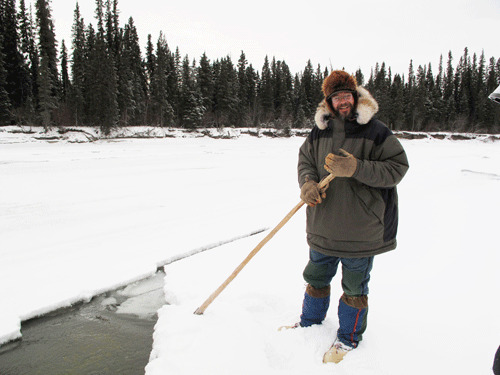

Dangerous ice the focus of research project
SAM CHARLEY SLOUGH — Winter travelers on the Tanana River can save a mile by taking the shortcut through this serpentine channel rather than following a lazy bend of the big river, but experienced dog mushers and snowmachiners avoid Sam Charley Slough. After driving here with a fleet of six snowmachines, we can see why.
Black, open leads yawn throughout the slough, and the gurgle of water holes sounds eerie in late winter. This bad ice has today drawn a team of ice-savvy travelers, scientists, and videographers. They are trying to find out why some river ice breaks beneath people and machines while other ice stays firm.
Sam Charley Slough is like other puzzling sections of the Tanana River that have patches of open water despite the kiss of sub-zero air all winter long. From his experiences out here dog mushing and snowmachining, Knut Kielland knows the slough well enough to point out the spot where wolves make a portage trail over a lobe of forest pinched by the slough. He mentions something strange he’s observed after the slough freezes hard each November.
“It’s fine until around New Year’s, and then it becomes unsafe,” Kielland says to Matthew Sturm and Chas Jones, two scientists who have joined him on the trip about 20 miles downriver from Fairbanks. “The ice goes to pot even as the temperature drops from minus 20 to minus 50 (degrees Fahrenheit). It continues to deteriorate despite colder air temperatures.”
Kielland is an ecologist at the University of Alaska Fairbanks’ Institute of Arctic Biology. He is teaming with Bill Schneider, curator of oral history for the Elmer E. Rasmuson Library, to map and document dangerous ice conditions throughout Interior Alaska with scientists and people who have traveled the river for years. Schneider and his colleague Karen Brewster are capturing on video the observations of experienced river travelers. With funding from the National Science Foundation, they plan to examine how local river travelers respond to changing ice conditions and how these conditions affect subsistence activities ranging from woodcutting to trapping. They also hope to bring together locals and scientists to learn more about the frozen platform used by so many winter travelers in Alaska.
An impressive lineup of bush experience was standing there on a snow-covered gravel bar on Sam Charley Slough that March day — among them were Sam Demientieff, who was born in Holy Cross on the Yukon and has traveled Alaska rivers for more than 60 years; Sturm, a snow scientist with the Cold Regions Research and Engineering Laboratory at Fort Wainwright who has traveled thousands of miles on ice; and Schneider, who has also run dogs on Interior rivers and lakes for many years.
As they stopped their machines and looked over the ice of Sam Charley Slough, the men agreed on one thing — ice, or the lack of it in spots, is tough to figure out. One idea is that the seepage of warm water springs weakens and erodes ice from below. This would seem to favor ice melting over shallow parts of the waterway, but the travelers on that March day found pools of open water several feet deep. On a recent trip to the village of Tanana, Kielland documented an area downriver with a skim of half-inch ice covering a 10-foot hole right next to the winter trail.
“That’s what scares me,” Kielland said. “Lots of deep holes right next to the trail. The ice gradient is very unpredictable. We want to identify what sort of mechanism can account for this. How is this heat delivered (to the ice)?”
Standing next to one another, Sturm, Schneider, Kielland and Demientieff looked out over Sam Charley Slough’s pocked surface. Each pointed to possible routes that a snowmachiner might weave through the dangerous ice, but it’s such a fickle substance that they all came to the same conclusion.
“I vote we go back the way we came,” Sturm said. Others nodded in agreement.
Six snowmachines turned around, buzzed single-file on a path back to the Tanana River, and left the mysteries of Sam Charley Slough for another day.
Video: A video of UAF ecologist Knut Kielland exposing thin ice on the Tanana River: http://www.youtube.com/watch?v=PUZ5ZtXLses






